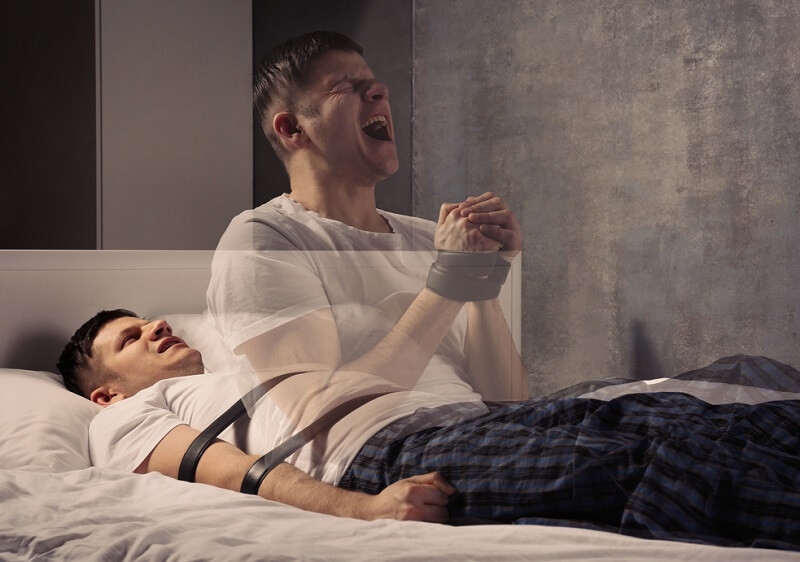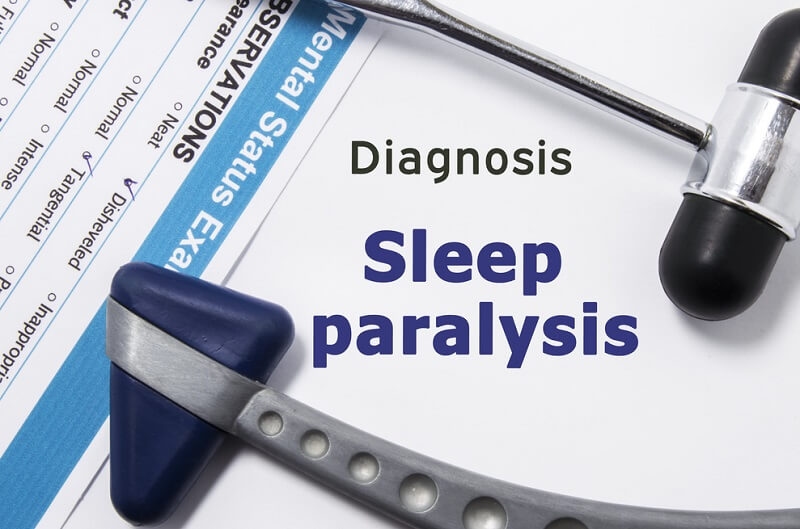Understanding The Alarming Sleep Paralysis Symptoms

Sleep paralysis can be defined as a phenomenon whose occurrence can be momentarily between sleep and wakefulness. The results of this condition usually lead to the inconvenience of restriction in movement or at times complete immobility. Even though the muscles are consciously in control of the brain, there is a lack of signal which causes a failure in the movement. This unsettling circumstance does not have a duration and might range from lasting for a few seconds to hours. Most often, sleep paralysis symptoms involve body aches, paranoia, and a comprehensive struggle that leads to fatigue and stress.
More about Terrifying Sleep Paralysis Symptoms:

In an episode of sleep paralysis, you are bound to experience numerous changes in your body, especially the ones you cannot control. One of the most frightening symptoms is the feeling of being paranoid due to complete immobility. Imagine that there are invisible handcuffs holding you down to your bed. Usually, because of paranoia, there might be effects like facing difficulty in breathing or feeling a heavy sensation of pressure on your chest, resulting in prolonged paralysis and a challenge to break free from it. These symptoms result in a traumatic mindset and a developing fear of sleeping if not treated soon.
Exploring the Dark Side of Sleep Paralysis:
When the sleep paralysis attack or an episode is stronger or occurs when you are at your lowest energy levels to get through it, the symptoms could be neurological. In such cases, you might be in extreme distress and could suffer from vivid hallucinations. These hallucinations can be experienced in any form be it auditory, visual, or tactile in nature. The brain might play tricks on you and you will believe there is a terrifying presence in the room. At times, reports show that people see shadowy figures, demonic entities, or even experience physical contact with them. Under the further extremities, these hallucinations can further intensify the fear and anxiety associated with sleep paralysis. The mind-altering reality shift that these sleep paralysis symptoms have, could be very intense and make it difficult for you to trust your senses.
The Science Behind Sleep Paralysis:
While sleep paralysis is generally resulting in fear and superstition for many, science has a clearer explanation of its underlying dynamics. During rapid eye movement (REM) sleep, the brain's motor cortex is deactivated and it leads to a stop on physical movements that may occur during dreams. In sleep paralysis, the brain's motor cortex is still in that state even after you have complete consciousness. As a result, it leads to you being completely awake and yet locked in a state of immobility. This is the reason, there is a close relativity between the body state when it is in REM sleep and the sleep paralysis symptoms.
Unraveling the Causes of Sleep Paralysis:

For every symptom that confirms the happening of sleep paralysis, there is an evident explanation or a cause for it. Loss of sleep, irregular sleep routines, and stress are commonly found causes of these episodes. Sleep disorders like narcolepsy and insomnia may also increase the likelihood of experiencing sleep paralysis. Additionally, a family history of sleep paralysis and certain medications can play a role in increasing the chances of it happening. Keeping a close observation of such instances that help you prepare for the potential occurrence of sleep paralysis is an important step to having a safe sleep.
Coping Strategies for Sleep Paralysis:
Once the evaluation of the sleep paralysis symptoms brings you to a diagnosis and confirmation of your conditions, you move to the stage of taking action for these symptoms to cure the problem as soon as possible. Although sleep paralysis is a distressing experience, there are several strategies that individuals can attempt to manage and reduce its frequency:
1. Establish a regular sleep routine:
Consistency is the key to developing a sturdier sleep routine. Begin going to sleep and waking up at time intervals every day. This will lead to acquiring your body to the patterns of sleep and regulate your body's internal clock, promoting better overall sleep quality. Set aside enough time for sleep, aiming for 7-9 hours of uninterrupted rest each night. Once you pick the routine and follow it, you can see the changes in the sleep paralysis symptoms you possess.
2. Create a sleep-friendly environment:
The things you own inside your bedroom and the colors, cluttering, and other such environmental factors play a crucial role in promoting quality sleep. Make sure your room is dark, quiet, and at a comfortable temperature to induce a peaceful sleep. Consider using blackout curtains, earplugs, or white noise machines to block out external disturbances are ways to reduce sleep paralysis symptoms. Additionally, get supportive mattresses, pillows, and comfortable bedding to enhance your sleep.
3. Reduce stress:
Stress and anxiety are the main reason why you struggle to sleep. These disturbances, result in aggravated sleep paralysis symptoms. Engaging in relaxation techniques helps manage stress levels and promotes more peaceful sleep. Explore practices like meditation, deep breathing exercises, progressive muscle relaxation, or yoga before bedtime. These techniques help calm the mind and prepare your body for restful sleep.
4. Improve sleep hygiene:
Once you are on the path of following good sleep hygiene habits, you can significantly start seeing improved sleep quality. This will also reduce the likelihood of experiencing sleep paralysis episodes. Avoid consumption of caffeine or nicotine around your bedtime to avoid their interference with sleep initiation and maintenance. Additionally, heavy meals or excessive fluids before bed may lead to discomfort or frequent awakenings during the night. Establish a relaxing pre-sleep routine, such as taking a warm bath, reading a book, or listening to soothing music to channel your body into slowly dropping down to rest. Limit exposure to screens, including smartphones, tablets, and televisions, to prevent the blue light from disrupting your sleep-wake cycle.
5. Seek professional help:
If sleep paralysis episodes increase in numbers or happen back to back which significantly impacts your daily life, it may be beneficial to consult sleep therapy. These sleep therapies are conducted by specialists who are trained to provide professional guidance and treatment options tailored to your specific situation. A sleep specialist conducts a comprehensive evaluation, including a sleep study, to diagnose any underlying sleep disorders and develop a personalized treatment plan. They may recommend therapies such as cognitive-behavioral therapy for insomnia (CBT-I) or prescribe medication if necessary.
Conclusion:
While sleep paralysis can be a frightening experience, it is essential to remember that it is a natural phenomenon rooted in the complex workings of the human brain. Understanding its symptoms and underlying causes can help alleviate the fear associated with sleep paralysis. Remember, sleep paralysis symptoms are just a temporary state, and with the right approach, a restful night's sleep can be within reach. Make sure you follow the coping methods mentioned above and regulate your sleep routine. Remember, good sleep is the secret to a good life.
This content was created by AI
-1717753922-r.jpg)